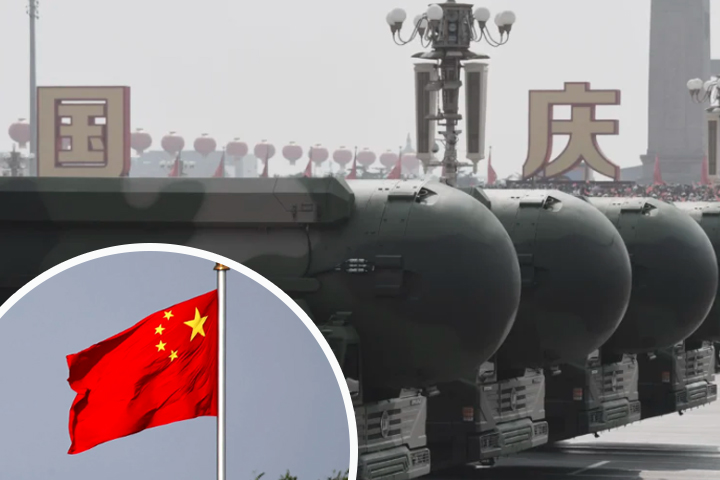


According to a Swedish research institute, by 2030, China's communist leadership would have the same number of intercontinental ballistic missiles—typically deployed as carriers of nuclear warheads—as the United States and Russia combined. However, the government is believed to have fewer nuclear weapons than the United States or Russia.
According to a new analysis from the Stockholm International Peace Research Institute (SIPRI), the quantity and kinds of nuclear weapons have grown globally, with China accounting for the majority of new warheads.
“[The] size of China’s nuclear arsenal increased from 410 warheads in January 2023 to 500 in January 2024, and it is expected to keep growing,” SIPRI said in a June 17 media release.
In comparison, North Korea grew its arsenal from 30 to 50 warheads, while India's increased from 164 to 172. The US possesses 3,708 warheads, while Russia has 4,380, according to the study.
“China is expanding its nuclear arsenal faster than any other country,” said Hans M. Kristensen from SIPRI and the Federation of American Scientists. “But in nearly all of the nuclear-armed states there are either plans or a significant push to increase nuclear forces.”
A Pentagon study from the end of 2023 assessed China's stockpile of warheads at 500, but stated that the nation aims for 1,000 by the end of the decade.
Countries throughout the world are putting increasing emphasis on nuclear deterrence, and it is thought that China maintained nuclear weapons on high operational alert for the first time this year.
There are now nine nuclear-armed countries: the United States, Russia, France, the United Kingdom, China, North Korea, Israel, India, and Pakistan. The United States and Russia account for 90 percent of all existing nuclear weapons.
According to the SIPRI assessment, there were an estimated 12,121 nuclear weapons in existence in January 2024, with 9,585 believed to be active and in stocks, and around 3,904 deployed with missiles or aircraft—60 more than in 2023.
Of those deployed, 2,100 were on high operational alert for ballistic missiles, around 100 more than the previous year, with virtually all belonging to the United States or Russia.
“While the global total of nuclear warheads continues to fall as cold war-era weapons are gradually dismantled, regrettably we continue to see year-on-year increases in the number of operational nuclear warheads,” said SIPRI Director Dan Smith. “This trend seems likely to continue and probably accelerate in the coming years and is extremely concerning.”
According to the analysis, the trustworthiness of nuclear weapons estimates differs each country. In certain situations, the estimate is based on a country's production of fissile material, specifically plutonium and highly enriched uranium, as well as its stated missile counts.
The United States, for example, declassified information on its nuclear stockpile in 2021, but not in 2022 or 2023. The writers came at their findings based on publicly available information.
The United States intended to increase its manufacture of new nuclear weapons from 10 plutonium cores per year to 30 in 2026 and 80 per year by 2030. However, the nation admitted in 2022 that the deadline was unattainable. The country's nuclear arsenal consists of heavy bombers, intercontinental ballistic missiles, and ballistic missile-armed submarines. According to SIPRI, these forces deploy around 3,508 nuclear weapons.
According to the research, India, Pakistan, and North Korea are all working on developing the capacity to put warheads on ballistic missiles.
As of January 2024, Russia has deployed 36 more warheads and operational forces than in January 2023.
In 2023, the United States and Russia's nuclear weapon stockpiles remained constant, with each country retiring 1,200 warheads from their forces and progressively dismantling them.
Russia has also threatened nuclear war for Western assistance to Ukraine, and in May 2024, it moved nuclear weapons and conducted maneuvers near the Ukrainian border.
“We have not seen nuclear weapons playing such a prominent role in international relations since the cold war,” said Wilfred Wan, Director of SIPRI’s Weapons of Mass Destruction program. “It is hard to believe that barely two years have passed since the leaders of the five largest nuclear-armed states jointly reaffirmed that ‘a nuclear war cannot be won and must never be fought.’”
In 2023, France resumed its efforts to create a third-generation nuclear-powered ballistic missile submarine (SSBN) and a new air-launched cruise missile.
India modestly increased its stockpile, with the main goal of maintaining a deterrence against Pakistan. However, it is also focusing on long-range missiles capable of reaching China.
“We are now in one of the most dangerous periods in human history,” said Dan Smith, SIPRI Director. “There are numerous sources of instability—political rivalries, economic inequalities, ecological disruption, an accelerating arms race. The abyss is beckoning and it is time for the great powers to step back and reflect. Preferably together.”